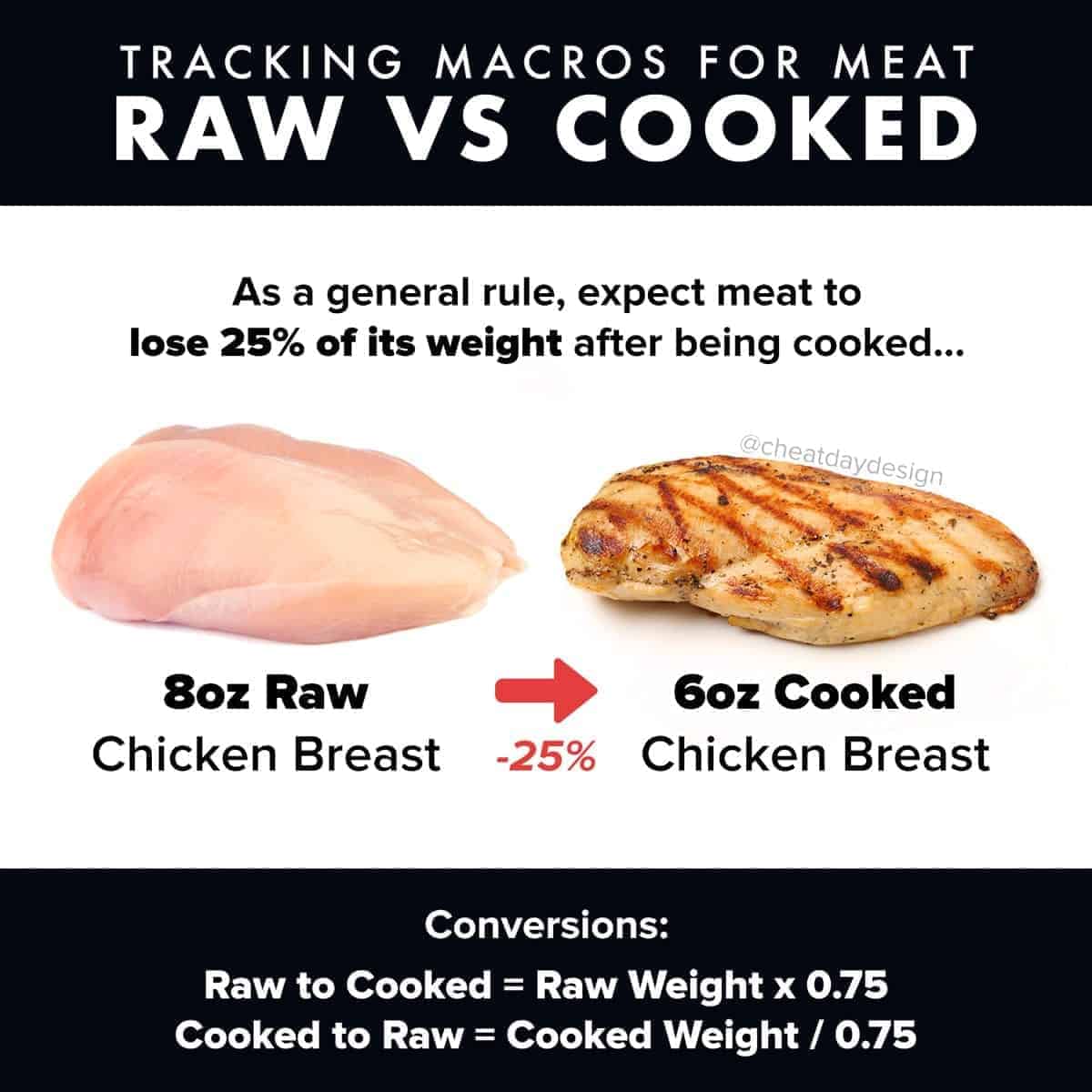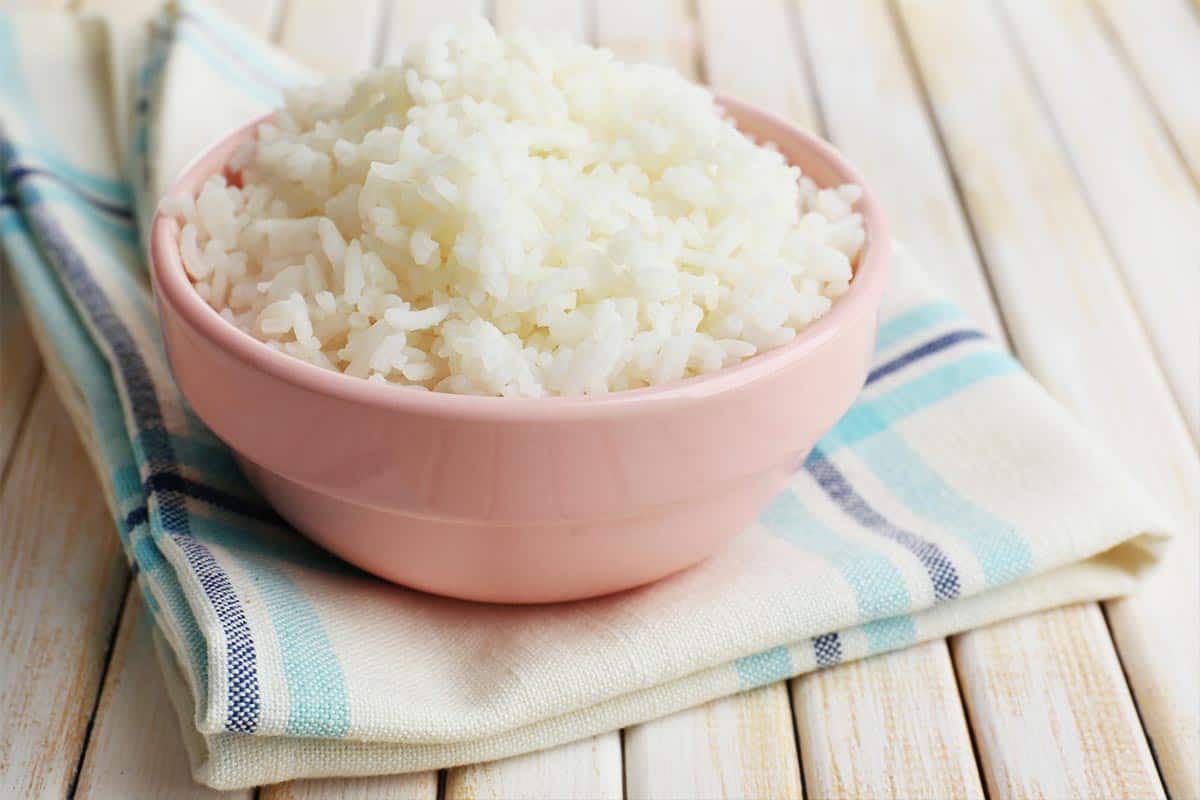What Is the Weight Difference Between Cooked and Raw Ground Beef
A very common question people have in regards to tracking their food is: "do I weigh my nutrient raw or cooked?"
Truthfully, you can do either, as long as you're consistent with it.
I e'er recommend weighing raw ingredients whenever possible, considering information technology is always going to be the most authentic. When you melt food, there are various cooking methods, sauces, ingredients, etc, that can all affect the final cooked weight.
When y'all stick with the raw weight, you eliminate all of those variables.
That's not to say that weighing your cooked nutrient is inefficient, but let'south explore why weighing food raw is most effective…
Nutrition labels always display information based on raw weight

The nutrition facts of your nutrient will e'er be based on raw weight, unless otherwise specified.
Nigh packages of bacon will say "ii pan-fried strips" every bit a serving, which refers to cooked bacon. Otherwise, if it doesn't specify, it implies that the nutrient is raw.
Let's look at ground beef as an example.
A single serving of 4 ounces of ground beef is based on four ounces raw ground beef.
When you cook that ground beef, those 4 ounces will cook down to nearly 3 ounces.
If you were to track the 3 ounces of cooked meat, you would track information technology equally 4 ounces of raw meat as seen on the nutrition label.
How can 3 ounces of cooked meat accept the same nutrition as four ounces of uncooked meat?
The only matter changing here is water weight. When the meat cooks, it loses water. Nothing else is changing!
This is where people get confused, then I want to say it again.
Even though meat weighs less, the nutrition is notwithstanding exactly the same.
Do calories or macros alter when you cook food?
Whether you're weighing your food raw or cooked, the calories aren't changing.
This throws a lot of people off. How can 2 ounces of raw rice have the aforementioned calories equally 4 ounces of cooked rice?
Isn't it double the corporeality?
Not exactly.
Sticking with the example of rice, when you melt it, all yous're doing is boiling information technology in water. The rice absorbs the h2o, leading to the serving doubling in size.
While the food weight has doubled, the volume is notwithstanding the aforementioned. Yous have the same verbal amount of rice!
If you lot accept a four ounce serving of cooked rice, it has the same exact calories as 2 ounces of uncooked rice.
Raw to cooked conversions for various foods
![]()
If y'all're reading this, yous likely want to know how to practice the conversion from raw to cooked weight, or vice versa.
Each food conversion is different, and there are quite a few variables to accept into account and then no conversion is going to exist 100% accurate all the fourth dimension. We're going to dive into some actual conversions, just retrieve that there are some factors that can affect the weight:
- Different cooking methods volition yield different weights. We're going to look at standard cooking methods (like grilling chicken) but something like an air fryer may yield a slightly different weight due to the fashion information technology cooks.
- Sauces and condiments volition affect your cooked food. If your meat has a marinade on it, the final cooked food may be slightly heavier than we'd normally expect, but it's not enough to worry virtually.
- Each food has unlike types that may melt slightly differently. Pasta has a ton of different shapes that use different ingredients, there are tons of different cuts of meat, etc. The following conversions are estimates , but they'll definitely exist close plenty for our purposes.
Raw vs cooked meat weight conversion

Raw to cooked meat conversion: Raw weight x 0.75 (example: 4oz raw ten 0.75 = 3oz cooked)
Cooked to raw meat conversion: Cooked weight / 0.75 (example: 8oz cooked / 0.75 = 8oz raw)
While it will vary slightly depending on the blazon of meat y'all use, you tin safely presume that cooked meat will lose about 25% of its weight once it'due south cooked.
I've personally tested this a scattering of times with chicken breast and can confirm that it is quite accurate. If you're looking at cooked vs uncooked chicken, information technology volition almost always melt downwardly from viii ounces of uncooked chicken to vi ounces of cooked chicken.
If you are looking at the nutrition facts on a package of meat, it volition be based on raw meat weight.
For ease, I recommend weighing the raw meat before cooking to accept out all the guesswork. You volition probable be adding spices, sauces, or marinades during the cooking process, which can affect the final weight.
Only in that location are certainly cases where y'all'll only be able to weigh your cooked meat, especially if somebody else is doing the cooking, and that's where this conversion comes into play.
If y'all observe yourself with an 8-ounce portion of cooked craven, you can carve up information technology by 0.75 to detect that the nutrition volition be equal to roughly 11-ounces of raw chicken. Information technology may not be verbal, but that volition exist a very close approximate.
Uncooked vs cooked pasta weight conversion

Raw to cooked pasta conversion: Raw weight x 2.25 (example: 2oz raw 10 two.25 = 4.5oz cooked)
Cooked to raw pasta conversion: Cooked weight / two.25 (example: 8oz cooked / two.25 = roughly iii.5oz raw)
We've talked a lot almost meat, which loses weight when it's cooked due to a loss of h2o weight.
Pasta tells a different story. When y'all melt pasta, it actually GAINS weight.
When yous await at the nutrition label of pasta, you'll typically encounter a serving size of 2oz. That is 2 ounces of uncooked pasta.
If you lot were to portion out 2 ounces of cooked pasta for yourself, you'd be really disappointed to find out that the serving is TINY. Instead, you demand to counterbalance out 4.5 ounces of the cooked pasta.
If y'all're tracking your pasta, recollect to counterbalance it earlier adding whatever kind of sauce.
Naturally, the sauce will add some extra weight which will throw off your conversion.
Uncooked vs cooked brown rice weight conversion

Raw to cooked brownish rice conversion: Raw weight x two (example: 2oz raw x 2 = 4oz cooked)
Cooked to raw chocolate-brown rice conversion: Cooked weight / two (example: 8oz cooked / 2 = roughly 4oz uncooked)
Similar to pasta, brown rice is going to increment in weight when cooked. Generally speaking, your rice is going to double in weight when cooked.
Rice is one of those foods that many people detect themselves weighing once it is cooked. For example, if you become Chinese food takeout, you'll find yourself with a pint of rice. And so, how do you mensurate out a serving? That'south when these conversions come into play!
The serving size you lot cull is up to you, just whatever you lot choose to counterbalance out, call up that the uncooked weight is half of any you are weighing.
If you portion out 6 ounces of cooked dark-brown rice and you are trying to track the nutrition, it will be the same nutrition equally three ounces of uncooked brown rice.
Uncooked vs cooked white rice weight conversion

Raw to cooked white rice conversion: Raw weight x 3 (example: 2oz raw x iii = 6oz cooked)
Cooked to raw white rice conversion: Cooked weight / 3 (case: 3oz cooked / 3 = 2oz uncooked)
White rice acts a fiddling bit differently than brown rice, and it will generally triple in size when cooked.
White rice is always my go-to when I order takeout. If yous observe yourself with some cooked white rice and want to figure out the diet, you'll need to separate the weight past 3.
If you portion out 6 ounces of cooked white rice, dissever it by iii to find that you are having the aforementioned nutrition as two ounces of uncooked white rice.
Should you track the raw or cooked weight of nutrient?
If y'all're tracking your macros (or merely your calories) it can exist tough to figure out how to accurately weigh your portions.
My recommendation, if you can aid it, is to always weigh your food raw. Information technology takes away any guesswork and defoliation, and it'southward consistent every fourth dimension! Recall that the labels are always based on raw weight, so it makes your life the easiest.
Whether it'south meat, potatoes, pasta, or rice, it'southward very helpful to weigh it out before you lot cook it. If y'all boil 4oz of rice, you know that you are making ii 2oz servings- so you don't even have to bother weighing it out at the end.
To me, that's always the easiest mode to go.
When it comes to meat, I always trim it down to the exact portion size I'd like. When it comes to chicken breast, I'll trim the raw chicken to the 8oz portion I want. And then when it'due south cooked, it doesn't matter what the weight is! We know that it'll melt down to vi ounces, but then we tin can play with marinades, sauces, and spices without any worry.
That being said, I totally empathize that sometimes you are not able to counterbalance your food before it's prepared. If y'all're ordering takeout or eating a dish that somebody prepared, you may not have the option to counterbalance your nutrient raw.
That's when these conversions come into play! While they may not exist 100% accurate, they'll help you get very close.
When information technology comes to tracking macros, we don't need perfection anyway- we just want to exist close.
And if you want to summate your own caloric or macronutrient needs, check out my free Calorie & Macro Estimator! It won't merely spit numbers out to you, information technology will actually explainwhy I recommend what I practice to make things as easy every bit possible for you lot!
Source: https://cheatdaydesign.com/tracking-macros-of-raw-vs-cooked-meat/
0 Response to "What Is the Weight Difference Between Cooked and Raw Ground Beef"
Post a Comment